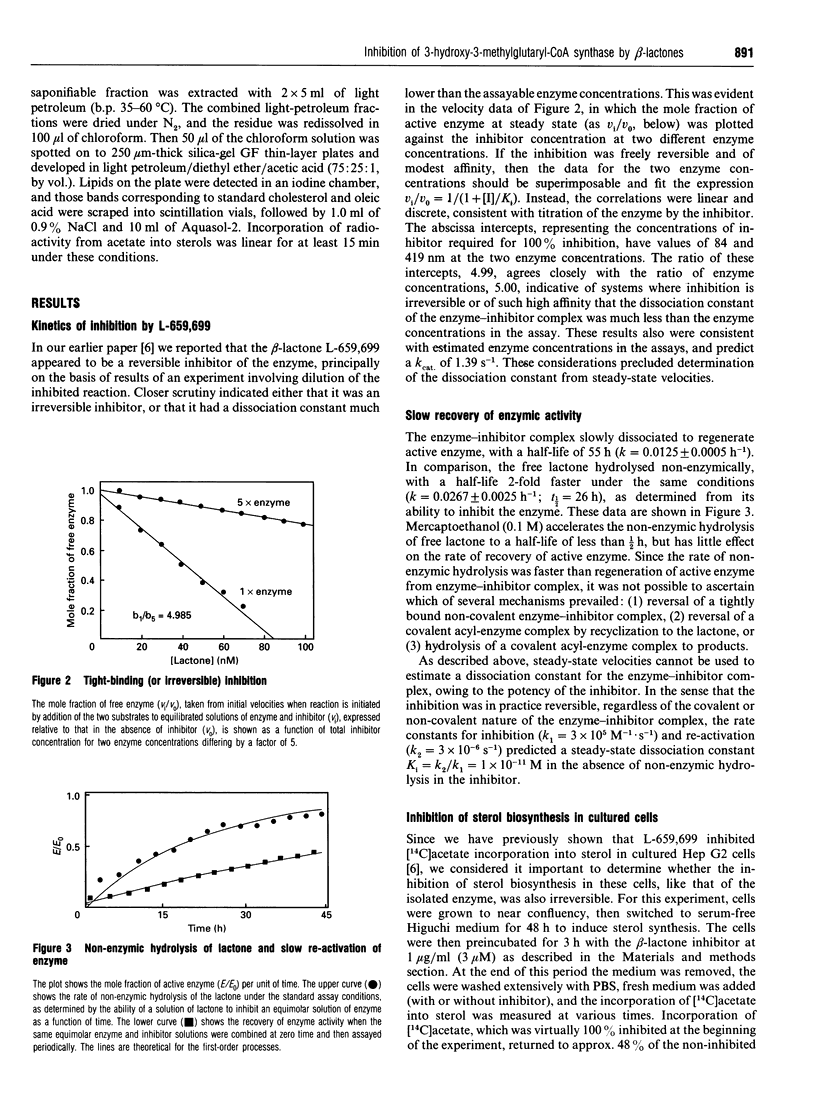Abstract
The beta-lactones L-659,699 [(E,E)-11-[3-(hydroxymethyl)-4-oxo-2- oxetanyl]-3,5,7-trimethyl-2,4-undecadienoic acid) and its radioactive derivative 3H-L-668,411 (the 2,3-ditritiated methyl ester of L-659,699) inhibited a partially purified preparation of rat liver cytosolic 3-hydroxy-3-methylglutaryl-CoA (HMG-CoA) synthase with an IC50 of 0.1 microM. These compounds were also found to inhibit the incorporation of [14C]acetate into sterols in cultured Hep G2 cells with an IC50 of 3 microM. New kinetic evidence indicated that inhibition of the isolated enzyme was irreversible. In contrast, sterol biosynthesis in cultured Hep G2 cells was rapidly restored upon removal of the compound from the medium of inhibited cultures, suggesting reversibility of inhibition in the cells. Radioactivity was found to be associated with a single cytoplasmic protein by SDS/PAGE of the cytoplasm of Hep G2 cells after incubation of the cells with the inhibitor 3H-L-668,411. This protein was identified as cytoplasmic HMG-CoA synthase. Binding of the radioactive compound to the enzyme was decreased with time if the radioactive inhibitor was removed from the medium. Exposure of a gel containing the radioactive enzyme-inhibitor complex to neutral hydroxylamine also resulted in a loss of radioactivity from the gel. The purified rat liver enzyme reacted with the 3H-ligand to form a stable enzyme-inhibitor complex which could be isolated by h.p.l.c. Radioactivity was also subsequently lost from this complex when it was incubated with neutral hydroxylamine. Incorporation of [14C]acetate into cholesterol in mouse liver was inhibited in a reversible manner after oral administration of the beta-lactone inhibitor. These studies, as well as the kinetic evidence presented, suggest that the beta-lactone inhibitors acylate HMG-CoA synthase in a reaction which appears to be irreversible in vitro, but is easily reversed in cultured cells and in animals.
Full text
PDF






Images in this article
Selected References
These references are in PubMed. This may not be the complete list of references from this article.
- Alberts A. W., Chen J., Kuron G., Hunt V., Huff J., Hoffman C., Rothrock J., Lopez M., Joshua H., Harris E. Mevinolin: a highly potent competitive inhibitor of hydroxymethylglutaryl-coenzyme A reductase and a cholesterol-lowering agent. Proc Natl Acad Sci U S A. 1980 Jul;77(7):3957–3961. doi: 10.1073/pnas.77.7.3957. [DOI] [PMC free article] [PubMed] [Google Scholar]
- Clinkenbeard K. D., Reed W. D., Mooney R. A., Lane M. D. Intracellular localization of the 3-hydroxy-3-methylglutaryl coenzme A cycle enzymes in liver. Separate cytoplasmic and mitochondrial 3-hydroxy-3-methylglutaryl coenzyme A generating systems for cholesterogenesis and ketogenesis. J Biol Chem. 1975 Apr 25;250(8):3108–3116. [PubMed] [Google Scholar]
- Greenspan M. D., Alberts A. W., Vagelos P. R. Acyl carrier protein. 13. Beta-ketoacyl acyl carrier protein synthetase from Escherichia coli. J Biol Chem. 1969 Dec 10;244(23):6477–6485. [PubMed] [Google Scholar]
- Greenspan M. D., Yudkovitz J. B., Chen J. S., Hanf D. P., Chang M. N., Chiang P. Y., Chabala J. C., Alberts A. W. The inhibition of cytoplasmic acetoacetyl-CoA thiolase by a triyne carbonate (L-660, 631). Biochem Biophys Res Commun. 1989 Aug 30;163(1):548–553. doi: 10.1016/0006-291x(89)92172-4. [DOI] [PubMed] [Google Scholar]
- Greenspan M. D., Yudkovitz J. B., Lo C. Y., Chen J. S., Alberts A. W., Hunt V. M., Chang M. N., Yang S. S., Thompson K. L., Chiang Y. C. Inhibition of hydroxymethylglutaryl-coenzyme A synthase by L-659,699. Proc Natl Acad Sci U S A. 1987 Nov;84(21):7488–7492. doi: 10.1073/pnas.84.21.7488. [DOI] [PMC free article] [PubMed] [Google Scholar]
- Higuchi K. An improved chemically defined culture medium for strain L mouse cells based on growth responses to graded levels of nutrients including iron and zinc ions. J Cell Physiol. 1970 Feb;75(1):65–72. doi: 10.1002/jcp.1040750108. [DOI] [PubMed] [Google Scholar]
- Lowe D. M., Tubbs P. K. 3-Hydroxy-3-methylglutaryl-coenzyme A synthase from ox liver. Purification, molecular and catalytic properties. Biochem J. 1985 Apr 15;227(2):591–599. doi: 10.1042/bj2270591. [DOI] [PMC free article] [PubMed] [Google Scholar]
- Mayer R. J., Louis-Flamberg P., Elliott J. D., Fisher M., Leber J. Inhibition of 3-hydroxy-3-methylglutaryl coenzyme A synthase by antibiotic 1233A and other beta-lactones. Biochem Biophys Res Commun. 1990 Jun 15;169(2):610–616. doi: 10.1016/0006-291x(90)90374-v. [DOI] [PubMed] [Google Scholar]
- Mehrabian M., Callaway K. A., Clarke C. F., Tanaka R. D., Greenspan M., Lusis A. J., Sparkes R. S., Mohandas T., Edmond J., Fogelman A. M. Regulation of rat liver 3-hydroxy-3-methylglutaryl coenzyme A synthase and the chromosomal localization of the human gene. J Biol Chem. 1986 Dec 5;261(34):16249–16255. [PubMed] [Google Scholar]
- Miziorko H. M., Behnke C. E. Amino acid sequence of an active site peptide of avian liver mitochondrial 3-hydroxy-3-methylglutaryl-CoA synthase. J Biol Chem. 1985 Nov 5;260(25):13513–13516. [PubMed] [Google Scholar]
- Miziorko H. M., Clinkenbeard K. D., Reed W. D., Lane M. D. 3-Hydroxy-3-methylglutaryl coenzyme A synthase. Evidence for an acetyl-S-enzyme intermediate and identification of a cysteinyl sulfhydryl as the site of acetylation. J Biol Chem. 1975 Aug 10;250(15):5768–5773. [PubMed] [Google Scholar]
- Omura S., Tomoda H., Kumagai H., Greenspan M. D., Yodkovitz J. B., Chen J. S., Alberts A. W., Martin I., Mochales S., Monaghan R. L. Potent inhibitory effect of antibiotic 1233A on cholesterol biosynthesis which specifically blocks 3-hydroxy-3-methylglutaryl coenzyme A synthase. J Antibiot (Tokyo) 1987 Sep;40(9):1356–1357. doi: 10.7164/antibiotics.40.1356. [DOI] [PubMed] [Google Scholar]
- Tobert J. A., Bell G. D., Birtwell J., James I., Kukovetz W. R., Pryor J. S., Buntinx A., Holmes I. B., Chao Y. S., Bolognese J. A. Cholesterol-lowering effect of mevinolin, an inhibitor of 3-hydroxy-3-methylglutaryl-coenzyme a reductase, in healthy volunteers. J Clin Invest. 1982 Apr;69(4):913–919. doi: 10.1172/JCI110530. [DOI] [PMC free article] [PubMed] [Google Scholar]



